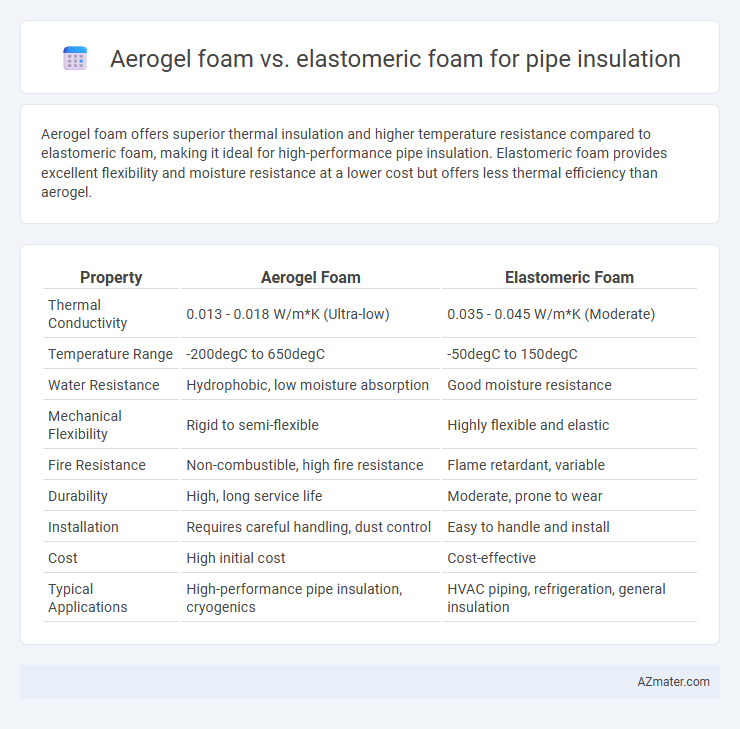Aerogel foam offers superior thermal insulation and higher temperature resistance compared to elastomeric foam, making it ideal for high-performance pipe insulation. Elastomeric foam provides excellent flexibility and moisture resistance at a lower cost but offers less thermal efficiency than aerogel.
Table of Comparison
| Property | Aerogel Foam | Elastomeric Foam |
|---|---|---|
| Thermal Conductivity | 0.013 - 0.018 W/m*K (Ultra-low) | 0.035 - 0.045 W/m*K (Moderate) |
| Temperature Range | -200degC to 650degC | -50degC to 150degC |
| Water Resistance | Hydrophobic, low moisture absorption | Good moisture resistance |
| Mechanical Flexibility | Rigid to semi-flexible | Highly flexible and elastic |
| Fire Resistance | Non-combustible, high fire resistance | Flame retardant, variable |
| Durability | High, long service life | Moderate, prone to wear |
| Installation | Requires careful handling, dust control | Easy to handle and install |
| Cost | High initial cost | Cost-effective |
| Typical Applications | High-performance pipe insulation, cryogenics | HVAC piping, refrigeration, general insulation |
Introduction to Pipe Insulation Materials
Aerogel foam offers exceptional thermal insulation with low thermal conductivity around 0.013 W/m*K, making it highly effective for minimizing heat loss in pipe systems. Elastomeric foam, known for its flexibility and moisture resistance, features thermal conductivity values typically ranging from 0.035 to 0.045 W/m*K, providing reliable insulation in HVAC and refrigeration applications. Choosing between these materials depends on factors like temperature range, moisture exposure, and installation requirements specific to pipe insulation projects.
What is Aerogel Foam?
Aerogel foam is an advanced insulation material characterized by its extremely low thermal conductivity and high porosity, making it one of the most effective insulators available for pipe insulation. It consists of a lightweight silica-based matrix filled with air, providing superior thermal resistance and excellent moisture resistance compared to traditional elastomeric foam. Aerogel foam's thin profile allows for space-saving insulation in tight areas, while maintaining durability and fire resistance, ideal for industrial and commercial piping applications.
What is Elastomeric Foam?
Elastomeric foam is a flexible, closed-cell insulation material made from synthetic rubber, commonly used for pipe insulation due to its excellent thermal resistance and moisture barrier properties. Unlike aerogel foam, elastomeric foam offers superior flexibility and ease of installation while providing effective condensation control and sound attenuation. Its durability and resistance to mold and UV exposure make it a preferred choice for HVAC piping and refrigeration applications.
Thermal Conductivity Comparison
Aerogel foam exhibits a significantly lower thermal conductivity, typically around 0.012 W/m*K, compared to elastomeric foam, which usually ranges between 0.035 to 0.045 W/m*K, making aerogel foam a superior insulator for pipe applications requiring maximum thermal resistance. The nanoporous structure of aerogel minimizes heat transfer through conduction, convection, and radiation, whereas elastomeric foam relies primarily on closed-cell air pockets for insulation. Despite its higher cost, aerogel foam provides enhanced energy efficiency and longer-term thermal performance in demanding insulation scenarios.
Moisture Resistance and Water Vapor Permeability
Aerogel foam exhibits superior moisture resistance and significantly lower water vapor permeability compared to elastomeric foam, making it highly effective in preventing condensation and protecting pipes in humid environments. Elastomeric foam, while offering decent moisture resistance, tends to have higher water vapor permeability, increasing the risk of moisture ingress and corrosion over time. Selecting aerogel foam for pipe insulation enhances durability and insulation performance by minimizing water absorption and vapor transmission.
Mechanical Strength and Flexibility
Aerogel foam offers superior mechanical strength with high compressive resistance and maintains structural integrity under pressure, making it ideal for demanding pipe insulation applications. Elastomeric foam provides excellent flexibility and stretchability, allowing for easy installation and adaptation to pipe movements without cracking. Combining these properties, aerogel foam excels in durability while elastomeric foam delivers better flexibility for dynamic environments.
Installation and Handling Differences
Aerogel foam offers superior lightweight properties and flexibility, making it easier to handle during pipe insulation installation, especially in tight or irregular spaces, while its brittle nature requires careful handling to avoid damage. Elastomeric foam is more resilient and less prone to cracking or crumbling, facilitating quicker, more forgiving installation with minimal specialized tools or delicate procedures. The installation process for aerogel may demand protective gloves and precise cutting techniques, whereas elastomeric foam can be more user-friendly and robust during handling and fitting.
Longevity and Durability
Aerogel foam offers superior longevity and durability for pipe insulation due to its exceptional thermal stability and resistance to moisture, compression, and aging, outperforming elastomeric foam in harsh environments. Elastomeric foam, while flexible and resistant to moderate environmental factors, tends to degrade faster when exposed to UV, ozone, and mechanical stress, reducing its effective lifespan. Choosing aerogel foam ensures extended insulation performance and reduced maintenance costs in industrial and commercial piping applications.
Cost-effectiveness and ROI
Aerogel foam offers superior thermal insulation with higher R-values per inch compared to elastomeric foam, leading to significant energy savings and faster return on investment despite its higher initial cost. Elastomeric foam is more affordable upfront and provides adequate insulation for moderate temperature ranges but typically results in longer payback periods due to lower insulation performance. Evaluating project scale, energy prices, and lifespan ensures accurate cost-effectiveness and ROI comparisons between these insulation materials.
Best Applications: Aerogel Foam vs Elastomeric Foam
Aerogel foam excels in high-performance pipe insulation applications requiring superior thermal resistance, such as cryogenic systems and industrial pipelines exposed to extreme temperatures, due to its ultra-low thermal conductivity and moisture resistance. Elastomeric foam is ideal for HVAC systems and chilled water piping, providing effective vapor barriers, flexibility, and ease of installation in environments with moderate temperature ranges. Selecting aerogel or elastomeric foam depends on factors like temperature extremes, space constraints, and moisture exposure in specific pipe insulation projects.

Infographic: Aerogel foam vs Elastomeric foam for Pipe insulation
 azmater.com
azmater.com